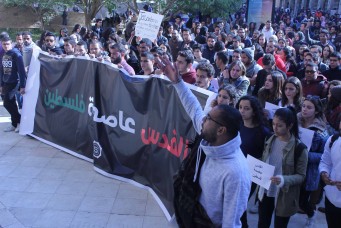Salafists on the Move
The sudden escalation of fighting in the north Lebanese city of Tripoli is troubling on two fronts and noteworthy on a third. The troubling dimensions are the chronic nature of urban warfare on Lebanon’s streets and the direct linkages between the Tripoli battles and the fighting in Qusayr, Syria. The noteworthy element is the growing role of Salafists.
The sudden escalation of fighting in the north Lebanese city of Tripoli is troubling on two fronts and noteworthy on a third. The troubling dimensions are the chronic nature of urban warfare on Lebanon’s streets and the direct linkages between the Tripoli battles and the fighting in Qusayr, Syria. The noteworthy element is the growing role of Salafists (fundamentalist Islamists) in the Tripoli fighting, which is part of a remarkable expansion of Salafist groups’ public action in political and military spheres across the Middle East in recent years.
Credible reports from Tripoli repeatedly chronicle the increased military role of Salafists in the city, directly reflecting the heightened clashes that mirror the fighting between pro- and anti-Syrian government forces in Syria. Tripoli has long had its own localized sectarian confrontation between the Sunni-dominated Bab el-Tebbaneh area and the majority Alawite and mostly pro-Assad Jabal Mohsen neighborhood.
Several new elements have transformed this chronic local tension spot into something much more ominous: the direct linkages between clashes in Syria and in Tripoli, the movement of growing numbers of Salafist fighters into north Lebanon and other parts of the country in recent years, the movement of fighters from north Lebanon into Syria to support anti-Assad rebels, and the Lebanese Salafists’ self-imposed role of countering the influence of Hezbollah in Lebanon and in the fighting in Syria, especially in Qusayr this month.
This is not a sudden or unexpected development. Salafists have operated in small numbers in isolated parts of urban or rural Lebanon for some years, often expanding in direct proportion to adjacent conflicts in Iraq and Syria. Pockets of militants battled the Lebanese security forces in the north a few years ago in the Tripoli region, the mountains to the east and Nahr el-Barid refugee camp. More recently, Lebanese security officials have been quoted in the press the past month as expressing concern about the growing numbers of Salafists that have been moving into Lebanon in recent years, anchoring themselves in Salafist-dominated urban neighborhoods like Bab el-Tebbaneh or in some Palestinian refugee camps that are outside the security control of the Lebanese state, like Ain el-Hilweh in the south.
The militant nature of some Salafists in Lebanon adds a significant dimension to the non-violent ways of the majority of Arab Salafists who tend to focus on recreating the “pure” Islamic lifestyles and societies they recall from the earliest decades of the Islamic era, during and immediately after the days of the Prophet Mohammad. Most Salafists across the Arab World in recent years have operated quietly at the neighborhood level, seeking primarily to promote basic Islamic values (faith, modesty, charity, mercy) in the personal and communal behavior of individual men and women. Active political participation in public life was left to Muslim Brotherhood-type groups who sought power at a national level, or to Al-Qaeda-like militants who waged their own battles across their imagined global battlefield.
So today we witness two important developments occurring simultaneously across parts of the Arab region. Some Salafists have emerged from the shadows to participate in public politics and contest parliamentary and executive power, such as in Egypt and Tunisia most dramatically; and, a few Salafist groups have turned to military means to defend their assorted local, regional or global causes, as we see in Lebanon, Syria and Iraq most clearly. This means that we now have at least three distinct and identifiable kinds of Islamist movements in the Arab world that are engaged in public political, social or military action: Hezbollah- and Hamas-like resistance groups that are heavily anchored in individual nationalisms; parties like En-Nahda in Tunisia and the Muslim Brotherhoods in Egypt, Morocco and Jordan that operate within the available channels of political participation and contestation; and, Salafist militants that use violence and intimidation to impose their strict ways on others in society.
It is fascinating that none of these three groups have demonstrated any credible capacity to provide programs that promote long-term socio-economic growth or address issues like educational quality, environmental protection, or cultural creativity. The dominant focus of these different Islamist groups on resistance and identity issues allows them to be very successful in opposition mode, but their ability to manage a city or a country remains mostly untested. In the few cases where they have enjoyed executive or legislative incumbency, like Egypt, Jordan, Gaza, Sudan and Tunisia, they have proved mostly amateurish and incompetent.
So the troubling acceleration of fighting in Tripoli represents much more than a challenge for the Lebanese people. It reminds us that the expanding militancy of Salafist Islamists is a growing regional phenomenon that once again—as with Islamism everywhere – highlights important grievances that cause people to worry and then to act, but does not suggest any practical solutions to those grievances and vulnerabilities that continue to spread across our increasingly fractured and frail region.
Rami G. Khouri is Editor-at-large of The Daily Star, and Director of the Issam Fares Institute for Public Policy and International Affairs at the American University of Beirut, in Beirut, Lebanon. You can follow him @ramikhouri.
Copyright © 2013 Rami G. Khouri—distributed by Agence Global



